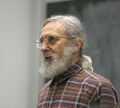Template:Selected anniversaries/April 8: Difference between revisions
No edit summary |
No edit summary |
||
| Line 44: | Line 44: | ||
||1913: Gyula Kőnig dies ... mathematician. Pic. | ||1913: Gyula Kőnig dies ... mathematician. Pic. | ||
File:Ernst_Ruhmer,_Technical_World_cover_(1905).jpg|link=Ernst Ruhmer (nonfiction)| | File:Ernst_Ruhmer,_Technical_World_cover_(1905).jpg|link=Ernst Ruhmer (nonfiction)|1913: Physicist [[Ernst Ruhmer (nonfiction)|Ernst Ruhmer]] dies. Ruhmer invented applications for the light-sensitivity properties of selenium, including wireless telephony using line-of-sight optical transmissions, sound-on-film audio recording, and television transmissions over wires. | ||
||1917: Winifred Asprey born ... mathematician and computer scientist. Pic. | ||1917: Winifred Asprey born ... mathematician and computer scientist. Pic. | ||
Revision as of 07:05, 8 April 2020
1461: Mathematician and astronomer Georg von Peuerbach dies. Peuerbach is remembered for his streamlined presentation of Ptolemaic astronomy in the Theoricae Novae Planetarum.
1541: Physician and archaeologist Michele Mercati born. Mercati will be one of the first scholars to recognize prehistoric stone tools as human-made rather than natural or mythologically created thunderstones.
1732: Inventor, astronomer, mathematician, clockmaker, and surveyor David Rittenhouse born. Rittenhouse will become the first Director of the United States Mint, hand-striking the new nation's first coins.
1858: Mathematician and philosopher Havelock publishes computational biography of David Rittenhouse.
1859: Mathematician and philosopher Edmund Husserl born. Husserl will argue that transcendental consciousness sets the limits of all possible knowledge.
1903: Mathematician Marshall Harvey Stone born. Stone will contribute to real analysis, functional analysis, topology, and the study of Boolean algebra structures.
1904: Mystic and thrill-seeker Aleister Crowley transcribes the first chapter of The Book of the Law.
1910: Kinetoscope used in series of math crimes, APTO criminal alert names Skip Digits as person of interest.
1911: Physicist Heike Kamerlingh Onnes discovers superconductivity.
1913: Physicist Ernst Ruhmer dies. Ruhmer invented applications for the light-sensitivity properties of selenium, including wireless telephony using line-of-sight optical transmissions, sound-on-film audio recording, and television transmissions over wires.
1959: A team of computer manufacturers, users, and university people led by Grace Hopper meets to discuss the creation of a new programming language that would be called COBOL.
2001: New Minneapolis-based dance company Rhizolith Group announces world tour.
2008: Mathematician Graham Higman dies. In mathematics, Higman contributed to group theory. Higman, a conscientious objector, worked at the Meteorological Office in Northern Ireland and Gibraltar during the Second World War.
2016: Signed first edition of Boxes purchased for an undisclosed amount by "an eminent mathematician residing in New Minneapolis, Canada."
2017: Mathematician Donald Sarason dies. Sarason made fundamental advances in the areas of Hardy space theory and Vanishing mean oscillation (VMO).














